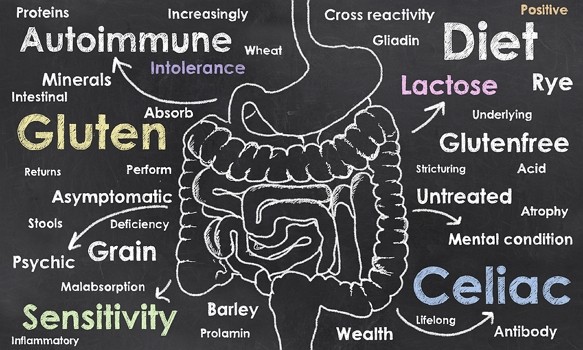Gluten-free diets have been talk of the town for a while now. Previously only the domain of those living with celiac disease, in recent years the idea has been picking up among the general public.
Many credit a gluten-free lifestyle to renewed energy, decreased abdominal stress, and even a slimmer figure, but you’ll find just as many people calling it a “placebo”. It’s time for the Trim Down Club to weigh in on the debate!
Gluten is quite widespread among food staples in the average person’s diet, so eliminating it isn’t a decision to be taken lightly. First, you must make sure you’ve learned all you can about what a gluten-free lifestyle would look like! Second, you must ensure you’re equipped with the knowledge to make healthy choices to fill any nutritional gaps and avoid common nutritional potholes that will arise once you make the transition.

We are pleased to provide a summary of the 10 most popular and authoritative sites on the subject of the Gluten Free Diet.
Gluten: the Basics
The world-renowned Mayo Clinic defines gluten as a protein found in grains such as wheat, rye, barley, and triticale (a cross between rye and wheat). In addition to pointing out that there is more than one type of gluten intolerance, including something called non-celiac gluten sensitivity, they also emphasize that cutting out gluten means finding gluten-free breads and pastas without losing sight of making healthy, whole food choices and meeting nutritional needs, while avoiding cross-contamination.
A quick Gluten-Free Dieting hack? Read the labels on the packaging!

Diabetes.org, the official website of the American Diabetes Association, also offers helpful lists of foods that do and don’t contain gluten:
Perhaps most helpful rescource: the list of “gluten surprises” – foods you wouldn’t expect to harbor the protein and yet do.
Gluten-Free: the Lifestyle
Those with celiac disease don’t have a choice, they are on the diet whether they want to be or not, but if you’re just trying out a gluten-free diet for yourself, you may be discouraged by the appearance of some special gluten-free versions of your favorite baked goods. The following websites can help you make the transition.
A publication known as Gluten-Free Living Magazine was started in 1995 to provide an “authoritative voice in the market.” It makes use of physician and dietitian advisory boards made up of experts in celiac disease and gluten intolerance to provide “trusted and reliable information about the gluten-free diet and lifestyle.”
Gluten-free dieting can be overwhelming at first, which is why the tools and articles from Gluten-Free Living can really come in handy. However, it is important to note that this resource is primarily focused on gluten-related conditions rather than overall health, and so does not consistently direct the user away from food ingredients that—while indeed gluten-free—are not recommended for other reasons.
Web MD offers this sight-byte slideshow on gluten-free living, which we should keep in mind as we make our own decisions in the great gluten debate. However, the emphasis on gluten-free here also misses some basic principles of healthy nutrition.
The Celiac Disease Foundation is a renowned leader in guidance for a gluten-free lifestyle. They are a non-profit organization, and all medical information provided is prepared by medical professionals and reviewed by its Medical Advisory Board for accuracy. They have a holistic approach, as reflected in this article.
Here’s a tip brought to you by celiac.org: rather than scrounging for substitutes, commit yourself to a balanced diet and enjoy the many food groups that don’t have gluten! For starters? There’s no gluten in fruit, vegetables, legumes, nuts and seeds, fish, dairy, and grain-like staples such as the beloved quinoa.
If you’re ready to jump in, head to Celiac Central, established by the National Foundation for Celiac Awareness (NFCA). Per their site, “NFCA is affiliated with the leading researchers internationally and supports collaboration and partnership among scientists and institutions to optimize research potential with the goal of improving the quality of life for those who have celiac disease and other gluten-related disorders.”
Celiac Central has a free Getting Started Guide available for download, as well as guidance for budgeting, cooking, and handling restaurants and holidays. While focused on celiac disease, there is an effort to steer the reader toward gluten-free options that also support general health.
Gluten-Free: Trend or Truth?
Many articles on the topic of the gluten-free trend have appeared in the scientific literature, as well as the popular media. In response to marketing pieces that encourage gluten avoidance as a panacea for various ills, and on the heels of research showing the topic to be a bit more complex than is often presented to consumers, the following commentaries recommend a careful approach.
- These days “gluten-free” can be fighting words. For one take on the gluten-free controversy (beneficial or just lucrative?), Maclean’s takes a look at the money behind the hype.
- From gluten-free vacation deals to gluten-free communion wafers, when has a health trend lost its credibility and become well, a fad? The New Yorker has an interesting take on gluten-free as cultural phenomenon.
- If you tend to favor personal anecdotes over things that read like a science report, this New York Magazine article might be for you. The writer buys Gwyneth Paltrow’s new cookbook and documents her seven-day detox experience (forgoing gluten, among other things). When she breaks the diet at the end of the week, she learns something.
A Final Word on Gluten-Free Food
The gluten-free diet has been on the scene for a while now, and just as options for celiac sufferers are becoming more widely available and supportive of general health, we are also inching closer to an agreement regarding the non-celiac gluten-free lifestyle. Properly researched and properly implemented, a gluten free diet can be beneficial for many people looking to take control of their nutritional lives.
In addition to providing an information hub for those interested in gluten and gluten-free living, the Trim Down Club offers the Menu Planner application—through which you can generate a gluten-free menu based on your food preferences and any other additional food sensitivities, as well as related research-based guidance articles—including those touching on low-gluten “super” foods that may be better suited to your needs—as well as providing support from a registered dietitian.




